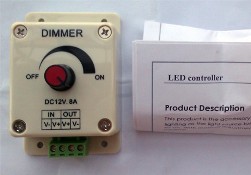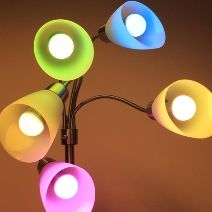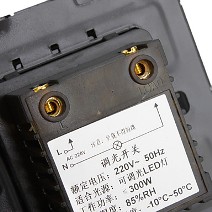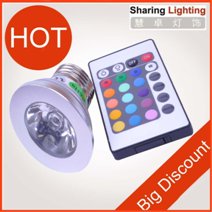Categories: Featured Articles » Sources of light
Number of views: 51627
Comments on the article: 4
Challenging LED Lamp Power Issues
The article talks about the power features of LED lamps and modules. Problems and features of power supply devices and control of such lamps are considered.
 LED lighting is rapidly invading our lives, trying to displace energy-efficient fluorescent lamps that have already become familiar. So far this is not very successful. Low power, narrow light focus, high brightness and the blinding effect of LEDs does not allow creating comfortable lighting in apartments. But these are all “childhood diseases” of new sources that will be overcome in the near future. But LED lamp power problem deserves closer attention.
LED lighting is rapidly invading our lives, trying to displace energy-efficient fluorescent lamps that have already become familiar. So far this is not very successful. Low power, narrow light focus, high brightness and the blinding effect of LEDs does not allow creating comfortable lighting in apartments. But these are all “childhood diseases” of new sources that will be overcome in the near future. But LED lamp power problem deserves closer attention.
Recall that LED is a device with the current principle of light generation. The direct conversion of electric current into light is due to the recombination of charges in the semiconductor transition zone. If the efficiency of conversion of charges into light radiation was close to 100%, this would remove a number of serious technical and technological problems faced by manufacturers high power led bulbs Today.
Of course, compared with the efficiency of incandescent lamps, not reaching 3%, and fluorescent lamps, in which the efficiency barely reaches 9%, LEDs with their 22% are indisputable leaders among light sources. However, 8 out of every 10 watts of electrical power supplied to the emitting crystal is converted to heat. And it is difficult to divert him, because silicon is a poor heat sink material.
 In short, LEDs do not tolerate high temperatures, and they respond to the same devices: they disable LEDs, accelerating diffusion processes in semiconductors. Ideally, at cryogenic temperatures, the life of the LED is unlimited. But at 100 degrees, he, at best, is 50,000 hours.
In short, LEDs do not tolerate high temperatures, and they respond to the same devices: they disable LEDs, accelerating diffusion processes in semiconductors. Ideally, at cryogenic temperatures, the life of the LED is unlimited. But at 100 degrees, he, at best, is 50,000 hours.
Therefore, those "golden" times have passed when a low-power LED indicator could be turned on through a limiting resistor and forget about its existence. With an increase in the efficiency and power of LEDs, it is necessary to balance on the shaky border of extremely high currents and temperatures.
The first LED lamps (SL) had a simple power supply design: a current-limiting capacitor, a rectifier, and then a sequential chain of emitting diodes. Moreover, they had significant pulsations of the light flux due to the low inertia of the LEDs. Such lamps have been used for lighting utility rooms, stairwells, and house number plates.
But they were completely unsuitable for lighting residential premises. First of all, through the unsatisfactory characteristics of the pulsating light flux. The advent of high-power LEDs and LED modules with power up to 50 and even 100W caused the need for development specialized power supplies for their normal operation.
Application linear current stabilizers for powering LED lamps It turned out to be acceptable only for currents up to 1A. Despite the wide range and precision output parameters, the microcircuits had large heat losses, required the use of radiators, and could not be used in high-power LED lamps. Today, individual LEDs and modules have integrated integral stabilizers, but such modules are used mainly when powered by rechargeable batteries.
 The way out was found on the way of application switching power supplies for LED lamps. In fact, these are semiconductor ballasts of compact fluorescent lampsoptimized for powering LED lamps.The advantage of pulse devices is the ability to work from the mains (220V) voltage, high efficiency, ease of stabilization current control.
The way out was found on the way of application switching power supplies for LED lamps. In fact, these are semiconductor ballasts of compact fluorescent lampsoptimized for powering LED lamps.The advantage of pulse devices is the ability to work from the mains (220V) voltage, high efficiency, ease of stabilization current control.
The disadvantages include the high price, inrush current input and ripple output current, reducing the life of the LEDs. With some complication of these devices, called "LED drivers", network interference is effectively suppressed. Such drivers are available in integrated design by many companies.
An example is the LM series of step-down and boost drivers with pulse width modulation from National Semiconductor. Unfortunately, the input voltage of the microcircuits is not more than 100V, which makes it difficult to directly connect them to the 220V network. Therefore, for LED lamps for mains voltage, drivers made on discrete elements are still used.
A wide range of drivers for indoor and outdoor installation offers the company from Taiwan Mean Well Enterprises. Its AC / DC converters cover the power range from 20 to 300 watts. The input voltage can vary from 90 to 264V, there is protection against overvoltage, short circuit, correction of the input power factor.
 Even more complex devices have drivers with the ability to control the brightness of LED lamps or color management when using LED modules as a load with tri-color RGB LEDs.
Even more complex devices have drivers with the ability to control the brightness of LED lamps or color management when using LED modules as a load with tri-color RGB LEDs.
For color management, specialized controllers with 4 or 6 outputs, program memory or control inputs from external devices are used. Such controllers allow you to get full color gamut, but additionally complicate the power supply equipment of such lamps.
LED brightness control in the case of using pulse devices with a wide range of input voltages, it creates considerable difficulties. Traditional dimmer circuits in this case do not work. We have to adjust the parameters of the driver output stages, which is far from simple and again complicates the power supply of such light sources.
The result is a paradoxical situation: to power and control just one semiconductor junction emitting light, it is necessary to use complex and expensive devices containing thousands or even tens of thousands of semiconductor structures. Given the variety of types and applications of LEDs, today, select a power device for led strip and lamps with the desired properties and parameters is a serious difficulty.
Further development of power supplies and control is seen in the creation of flexible, universal, programmable drivers containing a fairly powerful central processor. The external “strapping” of the chips will allow them to be used both directly to power the lamps from the network and to interact with external control devices. The necessary elemental base exists today. Stop only for a successful design.
See also on our website:How to install LED ceiling lights
See also at e.imadeself.com
:
